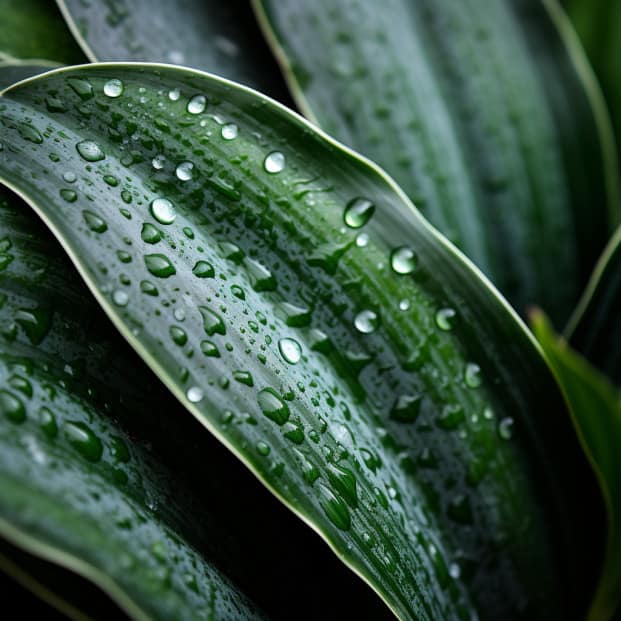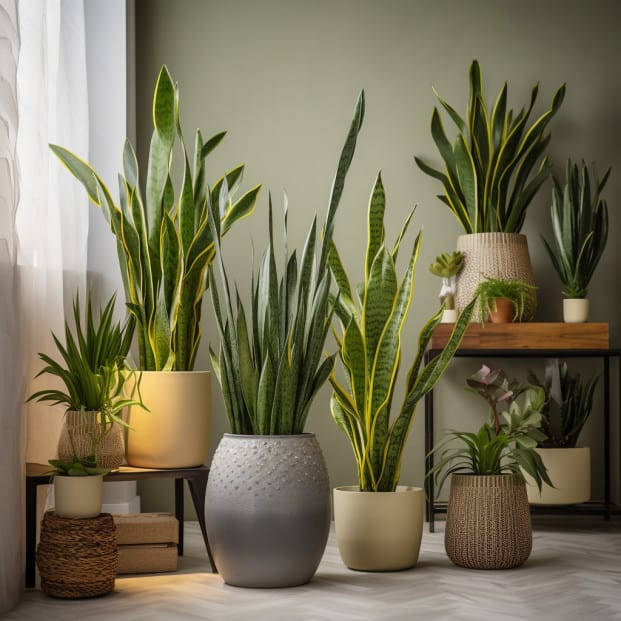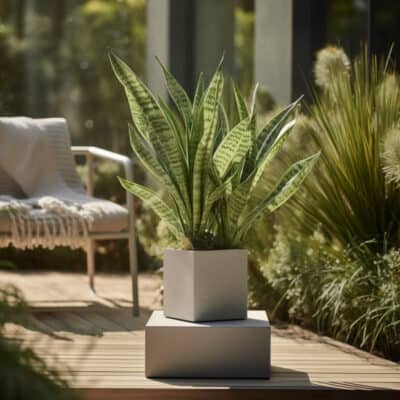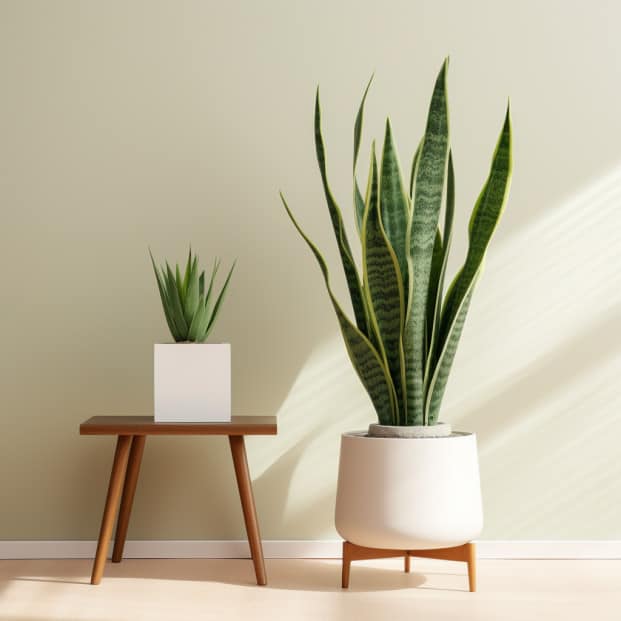According to Mr. Houseplant (1), Sansevieria Bacularis is a beautiful perennial succulent with tall cylindrical leaves that can grow up to 1.7 meters tall and produce white flowers when grown with sufficient light.
Read on to learn more about its benefits, how to care for this plant and keep it healthy.
KEY TAKEAWAY
Sansevieria Bacularis, what to know?
Sansevieria Bacularis, commonly known as snake plant, is a sturdy, low-maintenance houseplant with sword-like leaves.
To care for it, provide bright indirect light, allow the soil to dry between waterings, and ensure well-draining soil for optimal growth.
Unveiling the Hidden Power: Sansevieria Bacularis Benefits Explained
The snake plant, also known as sansevieria bacularis (2) or dracaena trifasciata, is an unassuming indoor plant with some seriously cool benefits.
Though not as trendy as more colorful houseplants, the hardy sansevieria has a lot to offer in terms of health, air purification, and design.
With its striking upright leaves, the snake plant naturally improves feng shui by bringing stability and structure to living spaces.
Its strong vertical shape promotes personal growth and vision.
The plant’s dark green leaves are also thought to symbolize prosperity and renewal.
But the benefits of sansevieria go far beyond the mystical! This hardy succulent is one of the best plants for filtering indoor air.
As it photosynthesizes, the snake plant releases oxygen while absorbing potentially harmful volatile organic compounds (VOCs) like formaldehyde and benzene.
The NASA Clean Air Study found sansevieria bacularis to be excellent at removing airborne toxins from enclosed spaces.
Some even say it can help reduce headaches, fatigue, and asthma symptoms.
Finally, snake plants make ideal low maintenance houseplants.
They tolerate low light and sporadic watering, thriving where other plants fail.
Their resilience makes them perfect for beginners or frequent travelers.
Simply place a sansevieria in an out-of-the-way spot and watch it flourish!
Sansevieria Bacularis Care 101: Nurturing Your Green Companion

Caring for a sansevieria bacularis or snake plant is refreshingly easy, even for beginners.
Here are some top care tips:
- Light: Snake plants thrive in virtually any indoor light conditions from bright indirect light to darker corners. Ideal light levels range from 50-150 fc.
- Water: Allow soil to dry out before watering. Water deeply then wait for the top inch to dry again before repeating. Underwatering is better than overwatering.
- Soil: Use a well-draining cactus/succulent soil mix. Re-pot every 2-3 years in spring, or when pot-bound.
- Fertilizer: Apply a balanced houseplant fertilizer at 1/2 strength every 2-3 months during the active growing season (spring through fall).
- Temperature: Ideal temps are 65-80°F. Avoid cold drafts.
- Humidity: Average room humidity is fine. Mist leaves occasionally for added freshness.
- Propagation: Take 3-4 inch cuttings and root in water or soil. Propagate in spring or summer.
- Pests: Watch for mealybugs and spider mites. Wipe leaves regularly and isolate any infected plants.
With proper care, snake plants can grow over 4 feet tall and live for decades.
Their low maintenance nature and air purifying abilities make sansevieria bacularis a staple houseplant with wonderful benefits for any home.
Beyond Aesthetics: Sansevieria Bacularis as a Feng Shui Element
With its striking vertical form and associations with prosperity, the sansevieria bacularis or snake plant has an important role in feng shui design.
Strategically placing this meaningful plant can help promote positive energy in a space.
In feng shui, the snake plant represents personal growth, focus, and reaching new heights.
Its sword-like leaves emerge straight from the soil, exemplifying the energy of growth and forward motion.
Accordingly, many recommend placing sansevieria plants in entryways or halls to encourage progress and direct movement through the home.
The snake plant’s hardy nature also symbolizes resilience and tenacity in feng shui.
The plant thrives even in poor conditions, reflecting a strong life force.
Use it in areas like home offices to bring determination and vitality to projects.
Finally, the sansevieria helps activate wealth and abundance areas in feng shui design.
Its lush green color and ability to propagate reflects ideas of fertility and prosperous new beginnings.
Add snake plants to financial zones like home office desks and near safes or vaults.
Their vibrant energy will stimulate financial flow.
With its powerful symbolism and striking form, the sansevieria bacularis brings several potent feng shui benefits.
Place it thoughtfully around the home to enhance the atmosphere and invite in positive energy.
Troubleshooting: Common Problems and Solutions with Sansevieria Bacularis

While generally hassle-free, snake plants can occasionally run into issues.
Here are some common problems and how to address them:
- Overwatering – Cause of many problems! Allow soil to fully dry out between waterings.
- Drooping leaves – From overwatering. Let soil dry before watering less frequently. Trim any rotten roots.
- Brown leaf tips – Caused by dry air or inconsistent watering. Mist plant regularly or improve watering schedule.
- Leaf spots – Can indicate fungal disease. Isolate plant and treat with fungicide. Improve air circulation.
- Root rot – Too much moisture causes roots to rot. Repot in fresh dry soil and water sparingly. Trim affected roots.
- Pests like spider mites – Common in dry air. Wipe leaves with insecticidal soap and keep area clean. Quarantine affected plants.
With good care, most issues can be prevented or corrected to keep sansevieria healthy.
Always allow soil to dry between waterings, provide bright indirect light, and isolate any infected plants.
DIY Propagation: Growing Your Sansevieria Bacularis Family
Propagating sansevieria is wonderfully easy. Here are a few simple methods:
- Division – Carefully divide rootbound plants, ensuring each division has some roots. Allow to dry 3 days before replanting.
- Leaf cuttings – Cut a leaf and allow the cut end to callous over. Place cut-end down in well-draining soil. New roots and shoots will sprout.
- Rhizome cuttings – Take a rhizome (underground root) section 2-3 inches long and plant shallowly in soil. Keep warm and moist until new growth emerges.
- Water – Suspend leaf cuttings in water until roots develop. Then transplant into moist potting mix. Change water weekly.
Within a few weeks or months, new snake plant babies will be thriving! Propagating lets you expand your collection and share sansevieria with friends. It’s fun and rewarding.
Sansevieria Bacularis vs. Other Varieties: Choosing the Right Snake Plant

With over 70 species, there are many snake plant varieties to choose from.
How does the sansevieria bacularis compare?
Sansevieria trifasciata – The classic snake plant with dark green, spear-like leaves. Very hardy and tolerates low light. Not as visually striking as other varieties.
Sansevieria cylindrica – Cylindrical leaves give a modern, architectural look. Slower growing but still adapts well to indoor conditions.
Sansevieria laurentii – Known for gorgeous yellow-edged leaves. Needs more light than other varieties but adds lovely contrast.
Sansevieria masoniana – Dramatic, wide leaves with a rippled texture. Requires bright light but filters air effectively.
Sansevieria bacularis – Tall green leaves with deep grooves. Very low maintenance and filters air pollutants like formaldehyde. Provides great vertical shape.
Sansevieria trifasciata ‘Hahnii’ – dwarf cultivar with thick, dark green leaves. Grows slowly but makes an excellent tabletop plant.
No matter your taste or space, there’s a sansevieria variety perfect for you!
Choose taller upright varieties like sansevieria bacularis to make a statement, or smaller rosette types for shelves and desktops.
All improve indoor air quality and require minimal care. With these resilient, architectural plants, you really can’t go wrong!
More on Snake Plant Benefits
Frequently Asked Questions
Are there different varieties of sansevieria bacularis?
Sansevieria bacularis comes in a variety of cultivars, with sansevieria bacularis ‘mikado’ being one of the more popular varieties.
It features leaves with distinctive yellowish stripes.
What are the light conditions for sansevieria bacularis?
Sansevieria bacularis can tolerate a wide range of light conditions, from indirect sunlight to partial shade.
It does best in medium indirect light.
While it can tolerate low light, it may not remain as stiff in good light conditions.
What type of care does sansevieria bacularis need?
As a perennial stemless succulent plant, sansevieria bacularis is known for being drought tolerant and easy care.
It does not need frequent watering.
Allow the top inch of soil to dry out between waterings.
Where does sansevieria bacularis grow naturally?
Sansevieria bacularis is native to west central tropical africa, including madagascar and southern asia.
It grows wild in these regions.
How do you propagate sansevieria bacularis?
Sansevieria bacularis can be propagated through leaf cuttings or rhizome cuttings.
Leaf cuttings root easily in potting soil or a potting mix.
Cut off thin cylindrical upstanding slender leaves and allow the cut ends to callus before planting.
What is the growth habit of sansevieria bacularis?
Sansevieria bacularis is a stemless succulent that grows in a rosette form.
It produces basal leaves up to 1-2mm in diameter and around 1 metres tall during its growing season.
The leaves have a stiff texture.
What kind of space does sansevieria bacularis need?
As a drought tolerant plant with thin cylindrical leaves, sansevieria bacularis does not need a large pot.
A 10-12cm diameter pot is usually sufficient.
Terracotta or plastic pots work well.
Ensure potting soil has good drainage to prevent root rot.
Are there any pests or diseases that affect sansevieria bacularis?
Sansevieria bacularis is generally very tough and pest/disease resistant.
However, overwatering can lead to root rot.
Mealybugs may occasionally be an issue.
Check leaves periodically and treat any issues early before they spread.
Is sansevieria bacularis toxic to pets?
All parts of the sansevieria bacularis plant are considered toxic if ingested by pets.
Keep it out of reach of dogs and cats to prevent poisoning.
Clinical symptoms can include vomiting, diarrhea and drooling.
Seek veterinary help immediately if intake is suspected.
Where can I purchase a sansevieria bacularis plant?
Many online plant retailers offer sansevieria bacularis, including varieties like the mikado snake plant, with free shipping.
Check reputable sites selling flowering plants and succulents.
Potted snake plant cuttings may also be available at your local home and garden center during the growing season.
Conclusion
Sansevieria bacularis also called snake plant is an easy to care for houseplant.
It grows stiff cylindrical leaves and tolerates low water.
I’ve had mine for over 5 years giving it minimum care.
Sansevieria bacularis thrives in medium light and endures dry conditions.
It fights off pests like mealybugs.
Houseplants are popular with over 36 million homes in America owning at least one.
Snake plant removes toxins like formaldehyde and serves as a natural air purifier.
Plus it comes in fun varieties with markings.
Have you grown sansevieria bacularis? Feel free to share your experiences below.
I’d love to hear success stories and tips from a plant parent like you.


